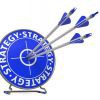Strategic Marketing & Product Management (ENG)

Predmet je vyučovaný v týchto odboroch:
Strategic Marketing and Product Management |
| Kester Osahenye, PhD., MMP |
| WHAT DO STUDENTS GAIN FROM THE STUDY AND FROM COMPLETING THIS SUBJECT |
|
Studying this subject will give you. Vistas of opportunity in knowing the elements of Marketing and Marketing Mix of “4 Ps” Product, Place, Pricing, Promotion. It will also give the student the opportunity to know how companies decide when and how much to invest in new products and services. It will discuss techniques for product planning, including product and technology roadmaps, and advanced development. We will contrast established techniques with how established or start-ups estimate their capital needs and size for Products Development. This course will also cover methods for identifying and sizing market opportunities, look at different kind of Market Segmentation. The Student should be acquainted and use frameworks such as PESTEL, SWOT and PORTERS Five Forces etc. After completing this subject: (a) Each student should know the concept of new product marketing process such as opportunity identification, concept selection, product design, pre-test and test marketing, launching and profit management; (b) Demonstrate the utility of formal models/frameworks and approaches in addressing relevant problems involving new products with a greater focus on the use of these models e.g. SWOT, PESTEL, PORTERS 5 Forces. (c) Sharpen the student’s problem solving skill sets and familiarity with the problems facing Multi-Product, Multi-Market organization in developing and segment its products / services. The student should know how products are designed for various marketplaces? What is the nature of distribution channels for successful versus unsuccessful products? The course is very useful for those students interested in pursuing careers in marketing, consulting and general product management. Studying this subject will mainly give you an opportunity to continuously consult your lecturer, an expert on the topic, about real problems, practical cases and situations, and to design a solution to these problems in the form of practically oriented case study (essay) elaborated under the lecturer’s guidance. As the consultations are not held in groups but only between you and the lecturer, you can consult also sensitive company issues, including specific data etc., without any worries about sharing this information with other students. The output from this subject is thus a valuable document that can be immediately used in your own company or job, providing high value-added thanks to one-to-one consultations with an expert. |
| EXAMPLES OF FIELDS AND TOPICS TO BE CONSULTED WITH THE LECTURER |
| Field 1 - Course overview, The Role of the Product Manager, strategies for Product Management and Product Life Cycle |
| Field 2 - Four Cs of Product Development: Customers, Competitors, Collaborators, Company |
| Field 3 - Building a Strategy for a fast changing business Environment for a changing business environment: Setting a product Mission Statement that fits different markets and industry using Theoretical frameworks: PESTEL (Political, Economic, Social, Technology, Environment and Legal Factors impacting product development), Porters 5 Forces & SWOT |
| Field 4 - Strategy: the PEST and Porter models the PEST and Porter models Role of competition through innovation. cturer’s area of competence can be agreed upon |
| More topics within the lecturer’s area of competence can be agreed upon |
| COMPLETION OF THE SUBJECT |
| In order to complete the subject, students elaborates an essay in which they address a specific topic from their practice related to the given subject, or one of the model topics prepared by the lecturer (see below). The essay should contain 7-10 pages in the A4 format, comprising at least 8 standard pages of text. The evaluation of the essay is done by the lecturer and expressed in percentage 50% and more means that the student has completed the subject successfully. |
| MODEL TOPICS FOR THE ESSAY |
| 1. New Product Development & Market Segmentation for Start-ups in Fashion Industry |
| 2. Developing Models of Needs, Products, and Markets for Fast Moving Consumer Goods |
| 3. The SWOT Analysis of Luxury Brands in a Youth Segment Markets |
| 4. Product Development in a Post Covid era, what are the Go To Market Strategy in a new market? |
| 5. Developing a Profitable Product Distribution Channels for educational products. |
| STUDY LITERATURE AND OTHER RESOURCES : |
| Supporting study materials elaborated by the lecturer (available online in the study system) |
| E-books available online: |
| The Product Management Reference Desk, Stevens Haines (2012) |
| Consumer Insight Maps: The Map As Story Platform In The Design |
|
“Turn Customer Input Into Innovation”, http://hbswk.hbs.edu/archive/2815.html |
| Other study literature (Authors: Name, Publisher, Year of publishing, ISBN): |
| Sara Beckman & Michael Barry. “Innovation as a Learning Process: Embedding Design Thinking” |
| John Kolko, “Design Thinking Comes of Age,” Harvard Business Review |
| Other useful resources (videos, online professional groups, blogs, discussions etc.): |
| https://hbr.org/2015/09/design-thinking-comes-of-age |
| Crossing The Chasm: Marketing and Selling High-Tech Products to Mainstream Customers by GGeoffrey Moore |
| How to Build Habit-Forming Products – By Nir Eyal |

